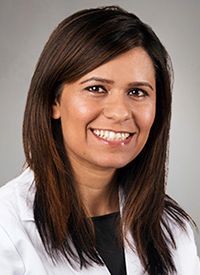Novel Molecular Markers at Forefront of NSCLC Research
Ardaman Shergill, MD, discusses the impact of tumor mutational burden, as well as RET and NTRK fusions, in the NSCLC paradigm.
Ardaman Shergill, MD

Ardaman Shergill, MD
Tumor mutational burden (TMB), NTRK, and RET are all molecular markers at the forefront of current research in non—small cell lung cancer (NSCLC), and investigators are in the early phases of learning how they can be used to clinically to benefit patients, said Ardaman Shergill, MD.
“Biomarkers are extremely important for identifying patients,” Shergill explained. “They help us determine or personalize therapy for patients and predict a response to what we are giving them. That is really important, especially in lung cancer, where mortality is so high.”
For example, with TMB, data from the phase III CheckMate-227 trial showed that the 1-year progression-free survival (PFS) rate was 43% for patients with high TMB (≥10 mut/Mb) assigned to receive the combination of nivolumab (Opdivo) and ipilimumab (Yervoy) versus 13% for those assigned to platinum-doublet chemotherapy. The FDA is currently reviewing a supplemental biologics license application for the combination based on these data, with an action date of May 20, 2019.
OncLive: Could you highlight the research exploring TMB as a biomarker for NSCLC?
In a presentation during the 2018 OncLive® State of the Science Summit™ on Advanced Non—Small Cell Lung Cancer, Shergill, an assistant professor of Medicine at the University of Illinois, highlighted the impact of TMB, as well as RET and NTRK fusions, in the NSCLC paradigm.Shergill: For TMB, I discussed 2 trials—although there are a lot more data available. One of the 2 trials that I talked about was CheckMate-227, which was a very complex trial designed to test nivolumab plus ipilimumab or nivolumab compared with chemotherapy based on PD-L1 expression. One of the co-primary endpoints of the trial was to look at TMB.
Once they enrolled patients and treated them, investigators looked at TMB. They defined TMB cutoff as 10 mut/Mb in that trial, and based on that, they looked at the responses of the patients as well as PFS. We don’t have any overall survival (OS) data reported at this point, but that showed that high TMB correlated with improved PFS as well as responses to immunotherapy versus chemotherapy.
What trials are looking at RET fusions as an emerging biomarker for NSCLC?
What is the prevalence of RET abnormalities?
They further looked at patients who had low PD-L1 expression and high TMB, and those patients also responded to immunotherapy. Therefore, in essence, this helped to select a group of patients who could respond to immunotherapy even when their PD-L1 status—which is a currently used biomarker—is not high.With RET, there were 2 drugs that I talked about in my presentation that were tested in rapid phase I studies. For these studies, there were only 1 or 2 patients enrolled, and the doses were rapidly escalated to treat those patients. Investigators showed significant intracranial and extracranial responses for a patient who progressed on multiple lines of therapy, and that was quite significant in that field. This was a patient who progressed through chemotherapy, immunotherapy, and targeted therapy, and then responded to the RET inhibitor, LOXO-292[KR1], at that time.It depends on the institution or where the person is being treated and how they perform molecular testing for patients. At most places, testing for mutations such as EGFR and ALK are becoming standard. Therefore, we test these mutations, but not everybody is getting comprehensive panel testing for the mutations the tumors might have.
Will comprehensive panel testing be standardized at some point down the line?
Could you discuss NTRK fusions as an emerging biomarker for NSCLC?
Nevertheless, we don’t have enough information about everyone’s mutation status to say whether lung cancer has 1% of RET-positive tumors or another cancer has 60% RET-positive tumors. Does thyroid cancer have a high predilection for RET-positive tumors? Because next-generation sequencing (NGS) or comprehensive panels are not routine everywhere, we may not have that information. However, it just makes a case to look for these within the NGS panels.I do think so; at least many academic places are moving towards that. More and more, even in the private NGS world, people are trying to make their panels more comprehensive to include many of these mutations. Therefore, that would become more of a standard going forth—to do comprehensive panel testing rather than a few mutations in a sequence.In my presentation, I spoke about a group analysis and large phase I studies for 2 drugs—larotrectinib and entrectinib—both of which showed significant response rates as well as complete responses (CRs), in the case of larotrectinib, in a smaller subset of patients. Again, it’s an interesting group of genes and therapy that is coming into the arena.
What challenges associated with these 3 biomarkers still need to be addressed?
I explained how cabozantinib (Cabometyx) is a medication we have used in thyroid cancer and other cancers, but is a non-specific NTRK inhibitor. Now, we are coming up with more specific NTRK inhibitors, which are looking promising in that setting. We saw a patient who had PFS benefits who had responses, and patients who had CRs when treated with NTRK inhibitors.For all 3 of these biomarkers, we are in the early phases of learning about them and seeing how we can use them clinically to benefit our patients. A lot of questions still need to be answered, as with any diagnostic test. How does it pan out for a larger population of patients? What are the side effects of some of these drugs? What is the demographic that we should be thinking about? Is this a younger nonsmoker population, an older-smoker population, or is it a certain racial group that fits more of these mutations? We don’t know enough about that yet.
The next thing is the diagnostic challenge. Diagnostic means have not been standardized yet, as was the case with some of the previous methods that we now routinely use. For example, for PD-L1 expression and ALK fusions, it took some time to come up with a standard diagnostic method for them. We face the same challenge with these biomarkers.
What is your overall outlook for these 3 biomarkers that physicians should know?
Lastly, for TMB, we look at the tumor tissue, and many times we are either diagnosing stage IV lung cancer with a fluid or a tissue that’s not sufficient for NGS to come up with TMB. Therefore, that’s why looking at alternative ways to diagnose and to do the panel is important. I also mentioned the B-F1RST study, which is looking at blood-based TMB testing and that seems to hold some promise, too.The main message is: the field of lung cancer is rapidly changing. We are pushing back at chemotherapy, and I don’t think that’s a bad thing. We are trying to provide patients with treatments that have less side effects and can be better tolerated. That is the case with TMB and for RET and NTRK—these biomarkers are opening up treatment options for patients who have progressed through multiple therapies. We’re testing to see if that’s going to pan out for a larger population and to see if we can move them upfront, but that remains to be seen.
Bristol-Myers Squibb Provides Update on the Ongoing Regulatory Review of Opdivo Plus Low-Dose Yervoy in First-Line Lung Cancer Patients with Tumor Mutational Burden ≥10 mut/Mb. Bristol-Myers Squibb. Published October 19, 2018. Accessed October 21, 2018. https://bit.ly/2ySdgOC.



